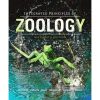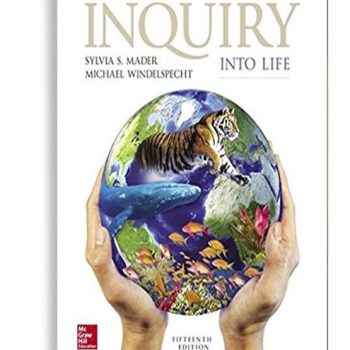Test Bank For Integrated Principles of Zoology 16th Edition Hickman-Keen-Larson-Roberts
Chapter 03
Cells as Units of Life
Multiple Choice Questions
1. The Dutch microscopist who sent letters to the Royal Society of London describing his many detailed observations of life, including units later known to be cells, wasA. Anton van Leeuwenhoek.B. Robert Hooke.C. Matthais Schleiden.D. J. Purkinje.
Accessibility: Keyboard NavigationBloom’s Level: 1. RememberGradable: automaticSection: Cell ConceptTopic: Cell Concept
2. Which of the following is NOT true about the Cell Theory?A. It states that all organisms are composed of cellsB. It states that all cells come from preexisting cellsC. It states that small organisms can arise spontaneouslyD. It is accepted today by biologists as applying to virtually all forms of life
Accessibility: Keyboard NavigationBloom’s Level: 1. RememberGradable: automaticSection: Cell ConceptTopic: Cell Concept
3. The surface of some parasitic flatworms and some insect tissues is a “syncytium” or living layer that contains many nuclei and cell organelles but is not partitioned by plasma membranes. These tissues consume food, respire, and produce wastes. Since the cell theory states that “all living things are composed of cells” what is the best statement to accompany this question?A. These tissues are not living because they are not cellularB. These tissues are obviously a bridge between nonliving and primitive living cellsC. The general concept of “life is cellular” still holds because these organisms still utilize cells sometime in their life, but this shows that plasma membrane partitions can be abandoned in some animalsD. This proves that a “vital force” beyond cell chemistry gives life to substances
Accessibility: Keyboard NavigationBloom’s Level: 4. AnalyzeGradable: automaticSection: Cell ConceptTopic: Cell Concept
4. A high-powered microscope that produces a surface image from scattered secondary electrons is theA. brightfield light microscope.B. transmission electron microscope (TEM).C. scanning electron microscope (SEM).D. confocal microscope.
Accessibility: Keyboard NavigationBloom’s Level: 1. RememberGradable: automaticSection: Cell ConceptTopic: Cell Concept
5. An important technique that allows biologists to trace the fate of chemicals in metabolic pathways is the useA. of the immunofluorescence microscope.B. of radioactive isotopes.C. of time lapse photography.D. of centrifugation.
Accessibility: Keyboard NavigationBloom’s Level: 4. AnalyzeGradable: automaticSection: Cell ConceptTopic: Cell Concept
6. The current theory of the structure of the plasma membrane is best described by which of the following models.A. The fluid-mosaic modelB. The unit membrane modelC. The electrochemical modelD. The nuclear envelope model
Accessibility: Keyboard NavigationBloom’s Level: 1. RememberGradable: automaticSection: Organization of CellsTopic: Organization of Cells
7. Major functions of the plasma membrane do NOT includeA. regulating molecules and ions that pass into and out of the cell.B. recognizing and communicating between different cells and tissues.C. maintaining connections between adjacent cells.D. producing proteins used in construction of the cell.
Accessibility: Keyboard NavigationBloom’s Level: 2. UnderstandGradable: automaticSection: Organization of CellsTopic: Organization of Cells
8. In a phospholipid bilayer, theA. Cholesterol is on the outside and plays a critical role in maintaining the fluidity of the membraneB. Glycoproteins are on the inside providing a supporting site for adhesive functionsC. Glycoproteins are anchored in the plasma membrane to assist in their transport functionsD. Water-soluble ends are oriented toward the exterior and interior of the cell, whereas the fat-soluble fatty acids are oriented toward the inside of the membrane
Accessibility: Keyboard NavigationBloom’s Level: 1. RememberGradable: automaticSection: Organization of CellsTopic: Organization of Cells
9. Biologists label various carbohydrates, fats and amino acids with radio-isotopes, place them in a cell culture, and allow time for cell metabolism. Then by disrupting cells in a blender and separating out various cell organelles, they find the radioactive molecules can be detected as part of various cellular compounds although visible cell structures appear unchanged. ThereforeA. these “food” molecules are used only for energy.B. most cell components are constantly being broken down and rebuilt.C. molecules diffuse at random through the cytoplasm and into cell organelles.D. radioactivity has an unusual role in metabolism of living cells.
Accessibility: Keyboard NavigationBloom’s Level: 2. UnderstandGradable: automaticSection: Cell ConceptSection: Organization of CellsTopic: Cell ConceptTopic: Organization of Cells
10. Which correctly describes ribosomes?A. Ribosomes contain both DNA and proteinB. Ribosomes are active in carbohydrate synthesisC. Ribosomal subunits leave the nucleolus and form ribosomes in the cytoplasmD. Ribosomes are found associated with the endoplasmic reticulum in prokaryotic cells
Accessibility: Keyboard NavigationBloom’s Level: 2. UnderstandGradable: automaticSection: Organization of CellsTopic: Organization of Cells









Reviews
There are no reviews yet.